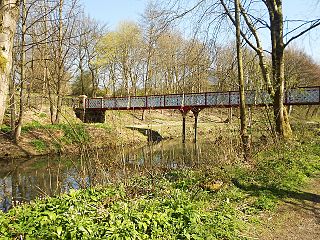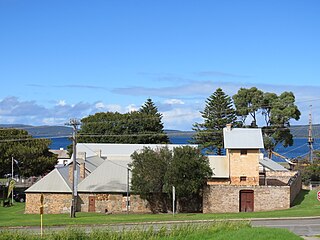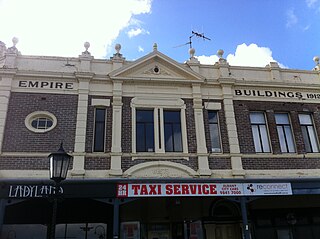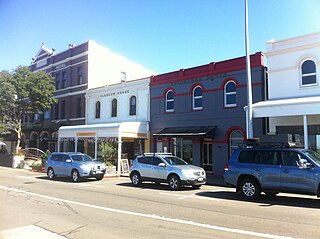
Moore Park is a small suburb located 3 kilometres (1.9 mi) southeast of the Sydney central business district, in the eastern suburbs of Sydney, in the state of New South Wales, Australia. It is part of local government area of the City of Sydney.

Brisbane Showgrounds is located at 600 Gregory Terrace, Bowen Hills, Brisbane, Queensland, Australia and was established in 1875. It hosts more than 250 events each year, with the largest being the Royal Queensland Show (Ekka).

Johnstone Park is a landscaped garden in Geelong, Victoria, Australia. It is bounded by Railway Terrace, Gheringhap Street, Little Malop Street, Fenwick Street, and Mercer Street. The park is surrounded by civic buildings including the Geelong Town Hall, Geelong Art Gallery, Geelong Library, Geelong Law Courts, and the Geelong Railway Station. A war memorial and bandstand feature in the centre of the park.

Centennial Parklands is the name given to a group of three urban parklands located in the eastern suburbs of Sydney, New South Wales, Australia. Comprising approximately 360 hectares, the lands encompass Centennial Park, Moore Park and Queen's Park. The Parklands are listed on the New South Wales Heritage Register, with various components of national, state or local heritage significance. The parks are contained within the local government areas of City of Randwick, Waverley Municipal Council, and City of Sydney.

Queen's Park is a roughly circular 22 acres (8.9 ha) Victorian park lying on sloping ground to the north-west of Bolton town centre, in Greater Manchester, England. Opened as Bolton Park on 24 May 1866 by Lord Bradford it was renamed in 1897 in honour of Queen Victoria's Diamond Jubilee.

The Meadows or Meadows is an area of Nottingham, England, south of city centre, close to the River Trent and connected to West Bridgford in the Borough of Rushcliffe by Trent Bridge and the Wilford Suspension Bridge. Victoria Embankment runs alongside the River Trent to the south of the Meadows and is home to the Nottingham War Memorial Gardens.
Tourist Drives in Western Australia are routes through areas of scenic or historic significance, designated by route markers with white numbers on a brown shield. Tourist Drives were introduced into Western Australia while Eric Charlton was the state government Minister for Transport in the 1990s. The 28 numbered routes collectively traverse more than 2,000 kilometres (1,200 mi) across the state. In addition to the Tourist Drives, there are unnumbered routes such as the Golden Pipeline Heritage Trail, and local governments may designate and maintain local scenic drives, generally unnamed and unnumbered.

Cremorne is a heritage-listed villa at 34 Mullens Street, Hamilton, City of Brisbane, Queensland, Australia. It was designed by Eaton & Bates and built from 1905 to 1906. It was added to the Queensland Heritage Register on 21 October 1992.

Queens Park is a heritage-listed botanic garden and park at Milford Street, Ipswich, City of Ipswich, Queensland, Australia. It was built from c. 1864 to 1960s. It was added to the Queensland Heritage Register on 27 September 2002.

Albany Convict Gaol also known as the Old Gaol is a restored gaol that operates as a museum in Albany, Western Australia.

John Moir was prominent businessman and politician who served as the Mayor of Albany in the Great Southern region of Western Australia.

York Street is the main street in the centre of Albany, Western Australia. It runs south from a junction with Albany Highway, Lockyer Avenue and Middleton Road downhill towards Princess Royal Drive and the Anzac Peace Park at the foot of the hill adjacent to Princess Royal Harbour.

Stirling Terrace, Albany is a street in the centre of Albany, Western Australia adjoining York Street.

White Star Hotel is a heritage listed building that operates as a hotel in Albany in the Great Southern region of Western Australia. The hotel is located adjacent to the Royal George Hotel on Stirling Terrace, once the commercial and social centre of town, overlooking Princess Royal Harbour. The building was named for the White Star Line, an important shipping and passenger line that once operated out of Albany.
Alexander Moir was an early settler in the Great Southern region of Western Australia.

The Royal George Hotel is a heritage listed building that operates as a hotel in Albany in the Great Southern region of Western Australia.

The Empire Buildings, also often referred to as the Empire Building, are a group of heritage listed buildings on the corner of Stirling Terrace and York Street overlooking Princess Royal Harbour in Albany in the Great Southern region of Western Australia.

Albany House is a heritage listed building located on the corner of Stirling Terrace and York Street overlooking Princess Royal Harbour in Albany in the Great Southern region of Western Australia.

Glasgow House is a heritage listed building located on Stirling Terrace overlooking Princess Royal Harbour in Albany in the Great Southern region of Western Australia.

The Federation Pavilion was a temporary structure erected in Centennial Park, Sydney, for use in the celebrations marking the Federation of Australia on 1 January 1901. It was used to swear in the members of the first Federal Executive Council, including Australia's first governor-general and prime minister. The pavilion was originally covered in ornate plasterwork, but the exterior was not preserved and soon fell into disrepair. In 1903, the wooden framework was purchased by the Municipality of Concord and moved to Cabarita Park in the suburb of the Cabarita. The property is now owned by the City of Canada Bay, and was added to the New South Wales State Heritage Register on 22 December 2000. The pavilion has appeared in the clear panel of the Australian five-dollar note since 2016, when the new Next Generation Banknote series went into circulation.



















